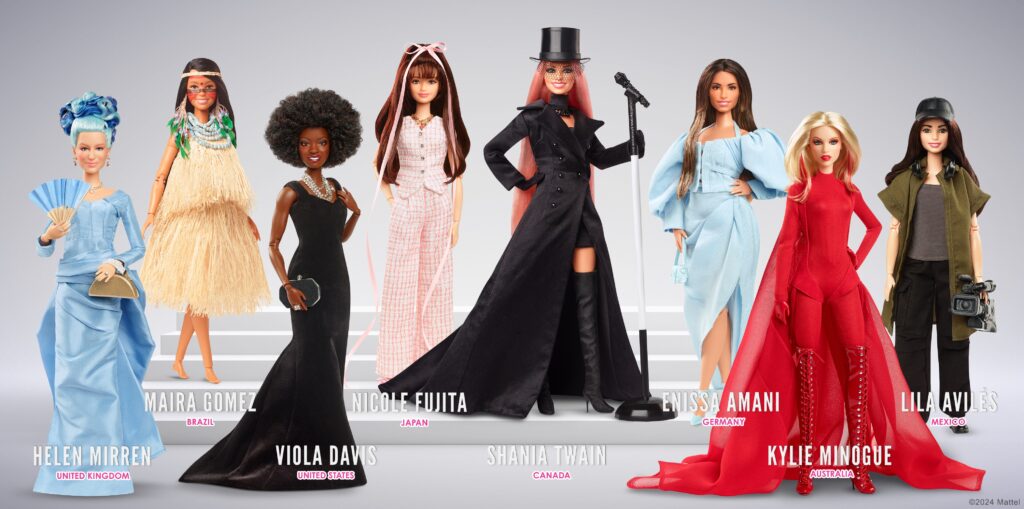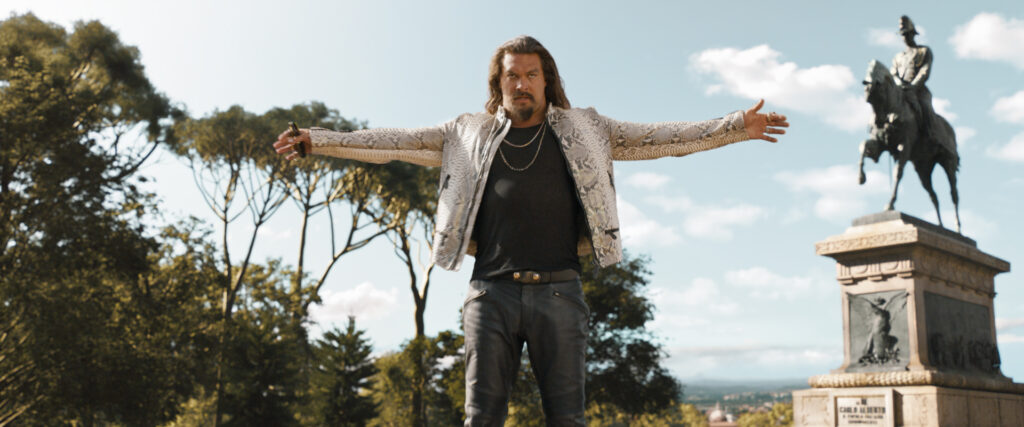March 6, 2024
The following is a press release from Mattel:

Mattel, Inc. (NASDAQ: MAT) announced its kickoff to celebrate the 65th anniversary of Barbie and over six decades of breaking down boundaries and inspiring girls through storytelling, encouraging them to be confident, daring, brave and legendary.
Since the brand’s inception, Barbie has helped girls explore their limitless potential through different roles and narratives – from encouraging self-expression through dress-up to playing out any of her 250+ careers. With Barbie by their sides, countless children have been able to imagine their own stories through play that help shape their real-life futures. As Barbie celebrates her 65th anniversary on March 9, the brand is sharing countless stories of empowerment and bringing her legendary legacy to life through the eyes and words of fans everywhere, starting with some of the most renowned storytellers out there.
“Barbie’s story has never been just about her. It’s about the countless young kids she’s inspired and the millions of stories she helped them imagine along the way,” said Krista Berger, Senior Vice President of Barbie and Global Head of Dolls. “For the past 65 years, Barbie has used her global platform to empower girls to dream big, explore their limitless potential, and direct their own narrative to shape their future. As we celebrate this milestone anniversary, we recognize over six decades of stories Barbie has helped write and the doll that continues to give everyone the opportunity to dream – and dream big.”
The Barbie brand is kicking off 65th-anniversary celebrations this March by:
- HONORING GLOBAL STORYTELLERS USING THEIR PLATFORM FOR GOOD with one-of-a-kind role model dolls made in their likeness in celebration of International Women’s Day. Barbie will recognize women worldwide who embody the brand’s mission to inspire stories to shape the future. The global lineup includes:
- Viola Davis (united States): Critically Revered Artist, Activist, Producer, Philanthropist, and Best-Selling Author – Viola Davis is an Oscar, Emmy, Tony, and Grammy winning actor. Her production company, JuVee Productions, focuses on giving a voice to the voiceless through impactful narratives defined by inclusion. Davis has partnered with multiple programs to eradicate childhood hunger in the United States.
- Shania Twain (Canada): Global Superstar, Celebrated Songwriter, and Style Icon – As one of music and fashion’s most renowned trailblazers breaking down barriers for women in country music, Shania Twain is the top-selling female country pop artist of all time.
- Dame Helen Mirren (United Kingdom): Acclaimed Actress and Advocate for Women’s Stories – Helen Mirren is one of the world’s best known and most respected actresses, along with being an advocate for embracing and celebrating self-expression, aging and fashion.
- Kylie Minogue (Australia): Artist – As a superstar artist, Kylie Minogue’s glittering career has kept her firmly rooted in the present whilst defining and celebrating much of our collective past.
- Maira Gomez (Brazil): Content Creator – Hailing from the indigenous community of the Tatuyo ethnic group in Amazonas, Maira Gomez aims to present the culture and traditions of her people to her nearly 7 million followers on social media.
- Lila Avilés (Mexico): Director, Producer, and Screenwriter – Lila Avilés is an award-winning film producer, having won more than thirty international festivals and whose movies have a strong reception from international critics.
- Nicole Fujita (Japan): Model – Nicole Fujita is a model and TV personality whose apparel brand will be opening its first retail store in March.
- Enissa Amani (Germany): Comedian – Enissa Amani is a stand-up comedian and political activist using her voice to create and produce viral shows addressing racism issues in Germany.
- Barbie is dedicated to showcasing more impactful stories and storytellers who can help inspire fans of all ages to craft their own narrative and unlock their limitless potential
- EXPANDING OUR COMMITMENT TO RESHAPE HOW SOCIETY SUPPORTS GIRLS’ EMPOWERMENT by entering our third year of partnership with Inspiring Girls International in continued support of the Barbie Dream Gap Project. This includes:
- Curating and delivering a year-long program focused on empowerment and growth for girls aged 12-14 across seven countries worldwide through transformational and engaging workshops. The custom program will help encourage girls to explore diverse career interests, develop leadership skills, and gain confidence. Furthermore, ongoing support and guidance from real-life mentors, including successful women leaders and Barbie role models, will underscore the message that “You Can be Anything”.
- Helping to close the Dream Gap through over $2 million in donations, since inception in 2019, to like-minded non-profit organizations with the vehicles in place to reach girls, highlighting 250+ careers, and empowering 25 million kids and counting, all with the shared goal to create more opportunities for growth for girls on a global scale.
- INTRODUCING AN ANNIVERSARY COLLECTION of products revisiting some of the most popular career dolls from Barbie’s impressive resume and introducing new celebratory and Fashionista dolls inspired by classic Barbie looks throughout her history. The 65th anniversary collection includes:
- The Barbie Career 65th Anniversary doll collection highlights three of the most popular careers held by Barbie since the doll’s creation including Farm Vet, Pop Star, and Astronaut.
- A new signature, collectible offering inspired by the original 1959 Barbie doll, dressed in a classic couture gown featuring white and black stripes, celebrating the iconic black and white striped bathing suit.
- 2024 Fashionistas dolls paying homage to Barbie fashion through the years by re-imagining iconic looks in modern day outfits. The new dolls are inspired by 65 years of style including the 1959 First Barbie, 1977 Superstar Barbie, 1985 Peaches ‘n’ Cream, and many more dolls.
- Barbie Cuutopia Plush figures inspired by iconic Barbie looks. Fans can dive into the glamour with embroidery, textured details and voluminous hair that celebrates Barbie doll’s signature looks with trendy kawaii style.
- UNO Canvas™ Barbie highlighting Barbie as a fashion icon, offering a premium collectible UNO deck designed with dolls and artwork.
- Hot Wheels® Barbie 65th Anniversary Corvette C8.R made and styled in the Hot Wheels Premium tradition for ultimate collectability.
- UNVEILING BARBIE-THEMED COLLABORATIONS with more than 40 brand partners across fashion, food, location-based entertainment, and publishing for fans to join in the Barbie celebration. Collaborations include:
- 1-800-Flowers.com, 24 ORE Cultura, A Leading Role, Aldo, Alex and Ani, CHI, Cheryl’s Cookies, Da Bomb, DefineMe Creative Studio Cre, Dragon Glassware, Franco Mfg., Funko, Hallmark Cards, Inc., Homesick, Impala Skate, Impressions Vanity, Innovative Designs, Keds, Lionel Trains, Loungefly, Love Your Melon, MakeUp Eraser, Monogram International, Nettie, PersonalizationMall.com, Posh Peanut, Quarto, Random House, Roots, SmartSweets, Sprinkles, Ukonic, and Unique Vintage.
- Barbie: The World Tour, a new illustrated book available March 19th, created by Barbie the Movie star/producer Margot Robbie and her stylist Andrew Mukamal with photography by Craig McDean and creative direction by Fabien Baron, in partnership with Rizzoli to capture the glamour and high style of the most popular doll in the world.
- Barbie by Assouline, a luxury, 340-page coffee table book fabricated in silk Barbiecore pink, which explores the brand’s evolution, decade by decade, with fascinating facts, insights and never-before-seen imagery that opened the imagination for what a doll – and a woman – could be.
- Stacy’s Pita Chips limited-edition specialty bags featuring a signature Barbie-pink metallic exterior, accompanied by a doll-size bag of chips. In celebration of female founders and International Women’s Day, Stacy’s Pita Chips will also support the Barbie Dream Gap Project with a $100,000 donation to Step Up to provide mentorship and programs for girls to define their ideal destination and get there – wherever that destination may be.
- Experiences near you including Barbie: A Cultural Icon (US), Barbie Dream Lounge(MX), Barbie: The Exhibition (UK), Malibu Barbie Café (US), World of Barbie (US), and Barbie Bahamas Beach Vacation at Atlantis.
- CELEBRATING AT RETAIL across the globe with in-store and online activation, including:
- An Amazon Barbie 65th Brand Shop featuring Barbie-themed products including toys and apparel.
- Target, featuring an exclusive “Write Your Legacy” Barbie-themed apparel and accessories capsule collection for girls 5 to 10, along with an assortment of Barbie-themed products across the store including featured items in toddler girls and juniors apparel. Find the collection of Barbie 65th Dolls in-store and on Target.com including an exclusive Barbie 65th Sapphire Doll.
- Walmart, featuring exclusive product at Walmart.com in March, followed by Barbie displays at Walmart locations across the country in May under the theme “65 Years of Inspiration, Dreams Made Here.” The collection will include new products across toy, apparel, accessories, sporting goods, and food and beverage.
Barbie’s 65th anniversary year follows a milestone moment in the brand’s history with the 2023 release of the Barbie movie, created in partnership with Warner Bros. Pictures. Since its theatrical debut last July, the critically acclaimed, award-winning Barbie movie has shattered multiple box office records by becoming the highest-grossing film of 2023, the highest-grossing film ever for Warner Bros. Pictures, and the highest-grossing film by a female director, Greta Gerwig.
Following Barbie’s birthday on March 9th, the brand will continue to celebrate throughout the year, including addition partnerships across next 65 days, and further activities through the Fall.
About Mattel
Mattel is a leading global toy company and owner of one of the strongest portfolios of children’s and family entertainment franchises in the world. We create innovative products and experiences that inspire, entertain, and develop children through play. We engage consumers through our portfolio of iconic brands, including Barbie®, Hot Wheels®, Fisher-Price®, American Girl®, Thomas & Friends™, UNO®, Masters of the Universe®, Monster High® and MEGA®, as well as other popular intellectual properties that we own or license in partnership with global entertainment companies. Our offerings include film and television content, gaming and digital experiences, music, and live events. We operate in 35 locations and our products are available in more than 150 countries in collaboration with the world’s leading retail and ecommerce companies. Since its founding in 1945, Mattel is proud to be a trusted partner in empowering children to explore the wonder of childhood and reach their full potential. Visit us online at mattel.com.













